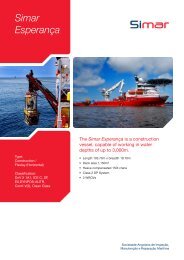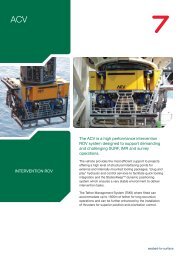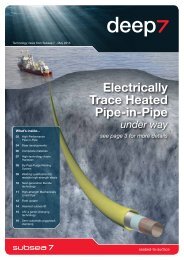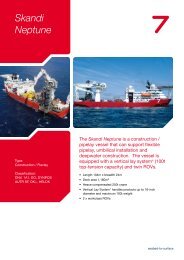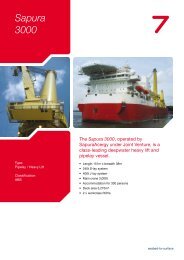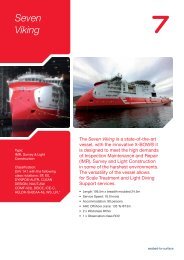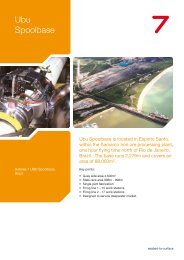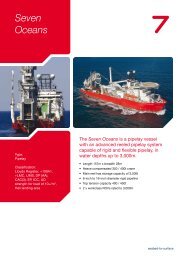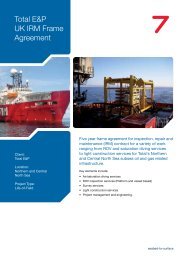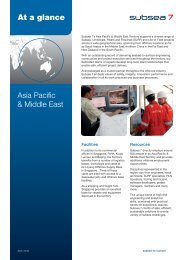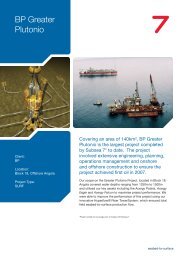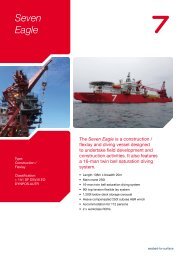World-class welding technologies - Subsea 7
World-class welding technologies - Subsea 7
World-class welding technologies - Subsea 7
Create successful ePaper yourself
Turn your PDF publications into a flip-book with our unique Google optimized e-Paper software.
Cutting-edge simulation<br />
<strong>Subsea</strong> 7 has developed one of the<br />
most powerful installation simulation<br />
packages ever built, including<br />
unique finite element analysis<br />
(FEA) capabilities, and successfully<br />
installed the hardware on board<br />
construction vessel the Seven<br />
Seas for effective on-site operative<br />
training.<br />
The programme was developed over a<br />
two-year period for the Block 31 project<br />
offshore Angola. An unusual aspect of<br />
this deepwater project is the mid-water<br />
pull-in of the flexible risers that connect<br />
the vertical risers to the FPSO. These<br />
operations are carried out at an average<br />
depth of 200m, which presented<br />
uncommon problems.<br />
Unlike most pull-ins, the tasks are<br />
performed in a situation where<br />
everything in the scenario is mobile.<br />
The Upper Riser Assembly (URA), while<br />
weighing several hundred tonnes, can<br />
be easily moved and rotated should the<br />
ROV push it. When the flexible risers<br />
are attached to the subsea winch wires<br />
and the load transferred from the vessel<br />
crane to the winches, the URA, which<br />
in itself is dynamic, tends to follow the<br />
riser lay direction for many metres -<br />
which has the potential to compromise<br />
the minimum bending radius (MBR) of<br />
the flexible.<br />
The situation was risk-assessed, and<br />
it was decided that the risks could be<br />
mitigated by building the nine different<br />
scenarios (there are nine flexible<br />
risers) in a simulator. This would allow<br />
procedures to be checked, and also<br />
facilitate pilot training. The simulation<br />
predictions were shown to correlate well<br />
with measurements taken before and<br />
during the actual offshore operation.<br />
The development of the simulator<br />
though 2010 and 2011 pushed the pilottraining<br />
software and hardware well<br />
beyond their existing capacity, due to<br />
the large number of flexible and moving<br />
objects in each scenario.<br />
Most simulation training takes place at<br />
<strong>Subsea</strong> 7’s site in Aberdeen, but for this<br />
project it proved more effective to train<br />
the ROV pilots, superintendents, and<br />
Block 31 installation simulator in use on board the Seven Seas<br />
bridge supervisors on board the Seven<br />
Seas, in an environment with which they<br />
are already familiar.<br />
The simulations feature:<br />
• Variable sea conditions which can<br />
produce realistic motions of the<br />
Seven Seas (<strong>Subsea</strong> 7’s construction<br />
vessel on Block 31)<br />
• Sea currents that can be varied<br />
in both strength and direction at<br />
different depths to replicate the<br />
currents throughout the entire<br />
2,100m water column<br />
• Two Hercules ROV systems, each<br />
with fully working manipulators and<br />
three selectable onboard cameras<br />
• Real-time FEA package calculating<br />
loads on, and MBR of, the flexibles<br />
• Two subsea winches complete with<br />
working line-out meters and load<br />
cells.<br />
The simulation FEA calculates the minimum<br />
bending radius of the flexible during ROV<br />
operations<br />
07<br />
The on-board simulator uses the<br />
existing Hercules 23 control console,<br />
with an additional six powerful PCs. A<br />
switch disconnects the topside control<br />
system from the ROV and changes<br />
operations from normal ROV control to<br />
simulation mode (this is only done when<br />
the vehicle is on deck!).<br />
For further information contact mike.bramley@subsea 7.com<br />
seabed-to-surface



